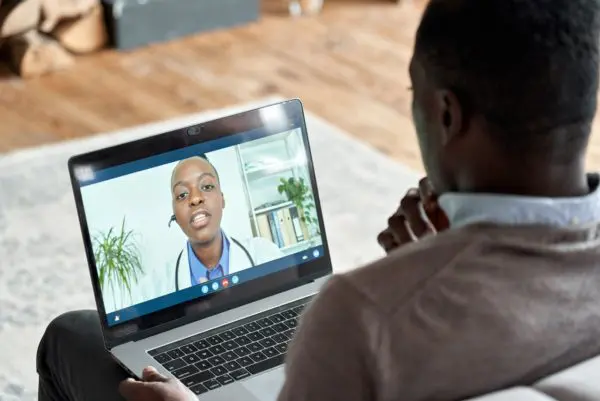
COVID-19 has had widespread impacts on most areas of health care. Cancer treatment, including that of malignant mesothelioma, has been no exception.
Some of these changes have proven bothersome. It can be stressful to wear a mask and undergo temperature screenings prior to medical appointments.
Other changes have provided distinct advantages over the former status quo. One such change is the widespread adoption of telemedicine. In fact, several recent studies investigated the merits of telemedicine in cancer care. According to those studies, telemedicine has at least three benefits for cancer patients, including those diagnosed with mesothelioma.
Telemedicine May Improve Survival in Some Cancers
A recent study investigated the effects of telemedicine on lung cancer patients. The study authors followed two groups of lung cancer patients after their initial treatment.
Half of the study patients, the control group, participated in routine follow-up care. The other half of the study patients used a telemedicine application called e-FAP. E-FAP stands for e-follow-up application.
The e-FAP tracked 13 patient symptoms. Participants reported symptoms through the e-FAP on a weekly basis. Patients who used the e-FAP had fewer scheduled imaging scans than the control group. However, the e-FAP alerted the oncology team if symptoms indicated potential cancer progression.
Both groups of patients could schedule additional follow-up appointments at their doctor’s discretion.
After a median follow-up time of nine months, researchers performed a mid-study analysis. According to that analysis, the median survival for e-FAP patients was 19 months. However, the median survival for control patients was 12 months.
This means telemedicine gave the study patients a survival advantage of about seven months.
Based upon this information, the study oversight committee recommended stopping the study. This allowed the remaining control patients to cross-over and use the e-FAP.
What Does This Study Tell Us?
The results of this study may seem counterintuitive. Why should infrequent check-ups prolong survival compared to more frequent check-ups? According to the study authors, a couple of facts explain this seeming contradiction:
- The e-FAP detects cancer progression better than imaging. Researchers tested the e-FAP before this study. From earlier tests, they knew the e-FAP could detect progression about five to six weeks earlier than scheduled scans.
- Patients wait for appointments, even when they have symptoms. Symptomatic patients often waited for scheduled follow-ups. Sometimes this meant patients lived with symptoms for weeks before confirming cancer progression. This wait-time led to decreased general health for some patients. Declining health may have impacted their tolerance for further treatment.
The researchers continued following these patients, discovering several of the points below.
Telemedicine May Improve Quality of Life in Some Cancers
Multiple studies have now demonstrated the positive effects of telemedicine on quality of life. The study mentioned above is one of them.
Researchers tracked quality of life for both e-FAP and control patients. At six-month follow-up, about 81% of e-FAP patients had stable or improved quality of life. Only 59% of control patients had stable or improved quality of life at the same time point.
Researchers believe the weekly check-ins provided by the e-FAP may explain this difference. According to the study, the e-FAP allows early management of physical and depressive symptoms. This may allow providers to manage care more effectively and delay negative health impacts.
Other research groups have also investigated the effect of telemedicine on quality of life. One study looked at several of these publications together. The authors analyzed results from eight clinical trials covering 635 lung cancer patients.
Across these studies, telemedicine provided the following benefits:
- Better quality of life
- Lower anxiety
- Lower depression
The study authors attributed some of these results to one simple facet of telemedicine. According to them, telemedicine is a uniquely superior way to overcome the obstacle of distance.
Simply put, telemedicine made follow-up easier on the patient. Thus, lowering the barriers to follow-up appointments may have improved care overall, leading to improved quality of life.
Telemedicine May Decrease the Cost of Cancer Care
Researchers from the e-FAP study mentioned above recently published further results. In addition to survival and quality of life, the e-FAP study tracked costs. Results show the cost of care was lower for telemedicine patients versus control patients.
Some of this difference came down to transportation. Patients using the e-FAP utilized private transportation more frequently than control patients.
The e-FAP group was also less likely to require an ambulance. Only 1% of the e-FAP patients’ trips used an ambulance. Conversely, 6% of the control patients’ trips involved an ambulance. That means conventionally treated patients used ambulances in five times more trips than e-FAP patients.
In the final analysis, researchers included costs for:
- Imaging scans
- In-person consultations
- Patient transportation
Overall, the cost of follow-up care was 28% lower in the telemedicine group using the e-FAP.
Researchers Agree: Telemedicine Is Worth Continued Investigation
In the studies mentioned above, researchers have highlighted the benefits of telemedicine. However, some experts have emphasized the need for a thoughtful approach to this evolving technology.
One recent review looked at telemedicine for patients with lung cancer and pleural mesothelioma. The authors wanted to understand patient preferences regarding in-person and telemedicine visits. There was no decisive preference either way. However, patients did emphasize the need for hope and reassurance during treatment.
The study authors urged the development of patient-centric follow-up programs. Such programs might take into account the anxiety caused by potentially unnecessary imaging tests. They might also take into account the benefits of telemedicine mentioned above.



